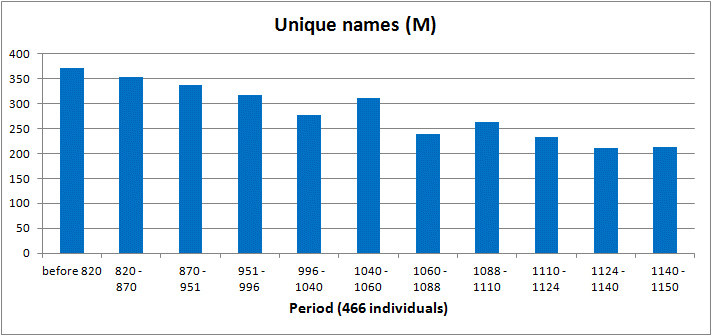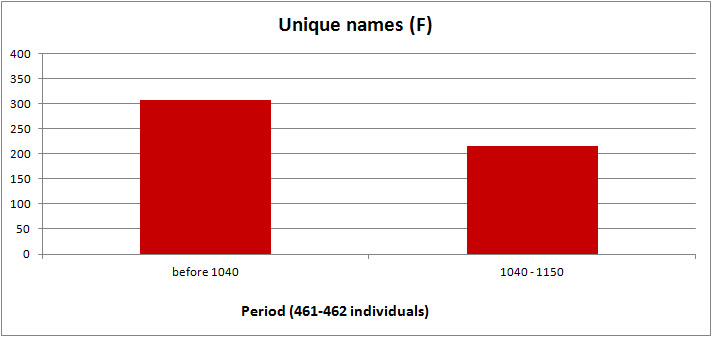Van der Schaar already noticed that the variation in personal names diminished over the centuries. He demonstrated this with only one example: a comparison of two lists of names, one from the register of possessions of the Saint Martin church in Utrecht (8th/10th century), and one from Alkmaar (early 12th century).
The first list contained 48 persons, of whom only one pair bore the same; virtually everybody in this list had a unique name. The second list, on the other hand, contained many duplicates: among the 77 persons, seven names occurred twice, two occurred three times, and two names (Herman and Thiedric) even four times. Only 49 of the 77 persons had a unique name.
(1)
On this page it has been tried to find more basis for the decrease in variation, with more than just one single example.
In the analysis, all masculine and feminine names from the present compilation have been included.
Furthermore, a comparison was made with the compilation from the later Middle Ages.
Various spellings of the same combination of elements (e.g. Theodric and Deodericus) were considered one name.
A comparison between the centuries was hampered by the fact that the numbers of registered individuals per century varied widely. For the first centuries the numbers were low. When only a small number of names has been registered, the chance of finding a pair of the same names is low.
(2)
In order to obviate this problem (starting with the men), the list of 5126 male individuals was sorted chronologically, and then cut into eleven equal blocks, each with 466 persons. The first block covered a long period (7th and 8th century) and the last block only a decade (1140 through 1150). Likewise, the 923 women were sorted and cut up, in this case in two almost equal blocks of 461 and 462 persons. Now a comparison could be made between comparable blocks.
(3)
For each block (or period) the number of unique given names was counted.

Figure 1. Number of unique male given names.
Each block represents 466 male individuals.

Figure 2. Number of unique female given names.
Each block represents 461 or 462 female individuals.
The graphs show, as expected, a decrease in the variation in the course of time.
The number of unique names diminished steadily, both among men and women. At the beginning of the study there were, per block of 460-470 persons, more than 300 different names, but at the end of the study period this had dropped to just over 200.
The decrease in variation continued after 1150. In the 13th century compilation, among 3146 male individuals, 347 different names were found.
(4)
The data from the 13th century could not be cut into blocks of circa 466. In order to make a comparison, the most recent 3146 male individuals from the present study were considered (from the year 1006 onwards). They had 822 different given names, more than twice as many as in the 13th century. This indicates that from the 11th/12th century towards the 13th century, the variation halved again.
The number of female individuals in the 13th century compilation was 503, with 125 unique names. In the present study the 503 most recent women (from the year 1030 onwards) had 235 unique names, almost twice the number from the 13th century. Thus, also among the women the variation in given names halved from the 11th/12th century towards the 13th century.
Van der Schaar stated that there was much more variation among women than among men. “Apparently, in the feminine line, it was easier to deviate from the habit of calling a child after someone - here, foreign names were adopted more readily”.
(5)
The numbers do not corroborate this statement. A comparison between the figures 1 and 2 shows that in corresponding periods, the numbers of unique names among men and women were roughly equal. In the early centuries the variation among women even seemed to be somewhat lower than among men.
Notes
1 - Van der Schaar (1953, p. 95).
The decrease in variation in given names had also been mentioned, but not really underpinned, by Leys (1959) and Gysseling (1965).
With quantitative foundation: Chedeville (1992): Brittany, between the years 1000 and 1280.
2 - For instance: in the 8th century 217 different male names were found, and in the 12th century three times as many: 672. From this, it cannot be concluded that the variation in names increased, because, on the other hand, in the 8th century only 244 male individuals were registered, of whom 196 (80%) with a unique name; in the 12th century these numbers were 1717 and 310 (18%), respectively.
3 - The number of 466 persons has been chosen arbitrarily; with another block size (e.g. just over 300, which resulted in 17 male blocks and three female blocks) the results were essentially the same. Roughly equal block sizes for men and women were chosen, in order to allow a comparison between the sexes.
4 - Names in the Low Countries 1250-1300.
5 - Van der Schaar (1953, p. 42).
|


